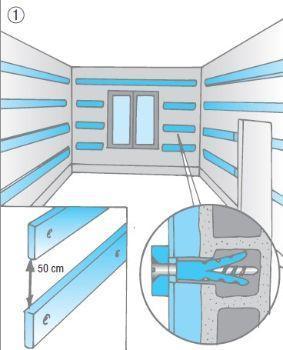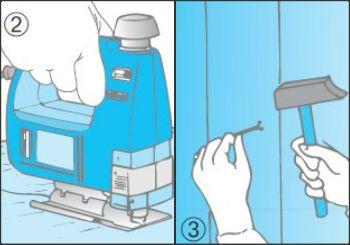Coating with wood
Post from EditorialsWooden panels allow you to change the aesthetics of an environment and to improve the thermal insulation with a simple intervention and low cost.
Coating with wood
The wood panels are a great material to cover the walls. They allow you to create a warm and welcoming atmosphere. There are panels available on the market made with many types of wood, of various sizes and with the exposed face worked in different ways. Usually the panels are supplied in standard sizes: 122x244 cm and 122x305 cm.
1) If the application of the panels takes place on the walls in communication with the outside, and then with the risk of condensation, or if the wall is affected by rising damp, it is convenient to fix the panels to a frame of laths. These strips will have a section of 30x30 mm and the gap that will be created will allow the possible moisture to be dried by the air circulation.
The casing must be achieved by creating a frame at the edge of the wall and inserting horizontal elements 50 cm away from each other. The application of the strips to the wall can be done with anchors. The heads of the screws should be recessed so as not to impede the application of the panels.
2) The panels are cut, preferably with a portable circular saw, which ensures accurate cuts and straights. For particular shapes the jigsaw is suggested.
3) For the installation, you can use steel nails that pass through the panel and take a hold on the rails of the frame.
4) Fix the skirting board to the paneling with steel nails.
5) If you want to apply the panels directly to the wall use the special glue applied to points.
6) The panel must be appropriately positioned and held in position for a moment by applying a certain pressure.
The editors recommend:
Wood paneling design
Natural, warm and elegant, the wood is a timeless material and always in fashion for the realization of inner linings of the walls. The great variety of green species used in the construction of the panels allows you to choose from a wide range of products with a differentiated aesthetic effect.
The choice of wood for the panels which cover the room, then, will be strongly linked to their aesthetic sense and the specific characteristics of the environment that will accommodate the panels. Hue and veins can be selected in such a way as to highlight the best features of each room or helping to draw attention away from any minor flaws.
The wooden panels can affect very clearly the perception of spaces: the vertical arrangement of the panels, for example, help to create the illusion of high ceilings, while the horizontal arrangement will be more suitable to obtain the extension of a visual room , or a single wall.
Wooden panels can also be exploited to create false ceilings, which help giving to the room a warmer look and to lower very high ceilings, maybe even hiding exposed beams not in line with the style of the underlying environment.
It should not be forgotten that the panels also have an important insulating function: they help to improve the thermal and acoustic insulation of buildings, creating a barrier against the dispersion evident from the results despite the low cost.
It is a solution that is particularly recommended in case of old buildings, for which no one has the possibility to intervene with operations of isolation more radical and more expensive.
Fir, larch, pine, oak and mahogany woods are among the most popular for the production of wooden panels. The mahogany, in particular, is able to offer a dark shade perfect for creating strong contrasts in individual rooms.
One should not think, however, that the natural color of the wood panels is an insuperable limit: the panels can also be painted, to get all the warmth of wood and colors at the same time able to bring added value in the individual spaces.
Wooden panels are suitable for environments in Nordic style, tastefully minimalist, or to create an atmosphere of Provence through panels painted in white: they are able to expand and illuminate the rooms, leaving it to the internal elements to confer an additional touch of heat, however, already present due to the material.
Coating the wood surfaces is an ideal solution for environments with a rural flavor, in which you want to get the predominance of the natural elements of all the other visible ones. Also in this case, to give to the environments the right personality, it can be enough to intervene on the ceiling, or only on some of the walls, then playing with contrasts of colors and materials.
80838 REGISTERED USERS










